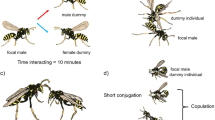Abstract
We investigated the behavioral response of male Paruroctonus boreus to male and female pheromones of conspecifics. Adult male scorpions actively search for females during the mating season, but lack visual cues to direct their movement. Chemical cues (pheromones) are thought to be responsible for directing movement. In a series of laboratory experiments, in Y-mazes, males were exposed to areas that had contained males and females from the same population and areas that had contained conspecifics from different populations. Males spent significantly more time in areas that had contained females from the same population but did not show a preference for areas exposed to females from different populations. Males also significantly avoided areas exposed to males from the same population. Our results suggest that P. boreus has a sex-specific response to pheromones and that this response may be population-specific.


Similar content being viewed by others
References
Ayyagari LR, Tietjen WJ (1986) Preliminary isolation of male-inhibitory pheromone of the spider Schizocosa ocreata (Araneae, Lycosidae). J Chem Ecol 13:237–244
Benton TG (1992) Determinants of male mating success in a scorpion. Anim Behav 43:125–135
Benton TG (2001) Reproductive ecology. In: Brownell P, Polis GA (eds) Scorpion biology and research. Oxford University Press, New York, pp 184–203
Brownell PH (1977) Compressional and surface waves in sand: used by desert scorpions to locate prey. Science 197:479–482
Brownell PH (2001) Sensory ecology and orientation behaviors. In: Brownell P, Polis GA (eds) Scorpion biology and research. Oxford University Press, New York, pp 184–203
Brownell PH, Farley RD (1979) Detection of vibrations in sand by tarsal sense organs of the nocturnal scorpion, Paruroctonus mesaensis. J Comp Physiol A 131:23–30
Fleissner G (1977) The absolute sensitivity of the median and lateral eyes of the scorpion, Androctonus australis L. (Buthidae, Scorpiones). J Comp Physiol A 118:109–120
Fleissner G, Fleissner G (2001) The scorpion’s clock. In: Brownell PH, Polis GA (eds) Scorpion biology and research. Oxford University Press, New York, pp 138–158
Foelix RF (1982) Reproduction. In: Foelix RF (ed) Biology of spiders. Harvard University Press, Cambridge, pp 172–210
Gaffin DD, Brownell PH (1992) Evidence of chemical signaling in the sand scorpion, Paruroctonus mesaensis (Scorpionida: Vaejovida). Ethology 91:59–69
Gaffin DD, Brownell PH (2001) Chemosensory behavior and physiology. In: Brownell P, Polis GA (eds) Scorpion biology and research. Oxford University Press, New York, pp 184–203
Gaskett AC (2007) Spider sex pheromones: emission, reception, structures, and functions. Biol Rev 82:27–48
Hadley NF, Williams SC (1968) Surface activities of some North American scorpions in relation to feeding. Ecol Soc Am 49:726–734
Haradon RM (1985) New groups and species belonging to the nominate subgenus Paruroctonus (Scorpiones, Vaejovisae). J Arachnol 13:19–42
Kaissling KE (1997) Pheromone-controlled anemotaxis in moths. In: Lehrer M (ed) Orientation and communication in arthropods. Birkhauser Verlag, Boston, pp 343–374
Locket A (2001) Eyes and vision. In: Brownell P, Polis GA (ed) Scorpion biology and research. Oxford University Press, New York, pp 79–106
Melville JM, Tallarovic SK, Brownell PH (2003) Evidence of mate trailing in the giant hairy desert scorpion, Hadrurus arizonensis (Scorpionida, Iuridae). J Insect Behav 16:97–115
Peretti AV, Carrera P (2005) Female control of mating sequences in the mountain scorpion Zabius fuscus: males do not use coercion as a response to unreceptive females. Anim Behav 69:453–462
Persons MH, Walker SE, Rypstra AL, Marshall SD (2001) Wolf spider predator avoidance tactics and survival in the presence of diet-associated predator cues (Aranae: Lycosidae). Anim Behav 61:43–51
Polis GA (1980) Seasonal patterns and age-specific variation in the surface activity of a population of desert scorpions in relation to environmental factors. J Anim Ecol 49:1–18
Polis GA (1990) Ecology. In: Polis GA (ed) The biology of scorpions. Stanford University Press, Stanford, pp 247–293
Polis GA (2001) Population and community ecology of desert scorpions. In: Brownell P, Polis GA (eds) Scorpion biology and research. Oxford University Press, New York, pp 302–316
Polis GA, Farley RD (1979) Behavior and ecology of mating in the cannibalistic scorpion, Paruroctonus mesaensis Stahnke (Scorpionida: Vaejovidae). J Arachnol 7:33–46
Polis GA, Sissom WD (1990) Life history. In: Polis GA (ed) The biology of scorpions. Stanford University Press, Stanford, pp 161–223
Roberts JA, Uetz GW (2004) Chemical signaling in a wolf spider: a test of ethospecies discrimination. J Chem Ecol 30:1271–1284
Sonenshine DE (1985) Pheromones and other semiochemicals of the acari. Annu Rev Entomol 30:1–28
Steinmetz SB, Bost KC, Gaffin DD (2004) Response of male Centruroides vittatus (Scorpiones, Buthidae) to aerial and substrate-borne chemical signals. Euscorpius 12:1–6
Warburg MR, Polis GA (1990) Behavioral responses, rhythms, and activity patterns. In: Polis GA (ed) The biology of scorpions. Stanford University Press, Stanford, pp 225–246
Wyatt TD (2003) Pheromones and animal behavior. Cambridge University Press, New York
Acknowledgments
We would like to thank Jennifer Fernandes and Jen Wortham for kindly reviewing this manuscript in its final stages.
Author information
Authors and Affiliations
Corresponding author
About this article
Cite this article
Miller, A.L., Formanowicz, D.R. Friend or foe: behavioral responses to conspecifics in the northern scorpion, Paruroctonus boreus (Scorpionida: Vaejovidae). J Ethol 29, 251–256 (2011). https://doi.org/10.1007/s10164-010-0250-0
Received:
Accepted:
Published:
Issue Date:
DOI: https://doi.org/10.1007/s10164-010-0250-0




